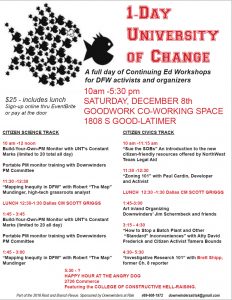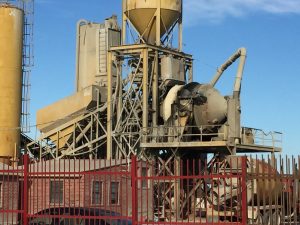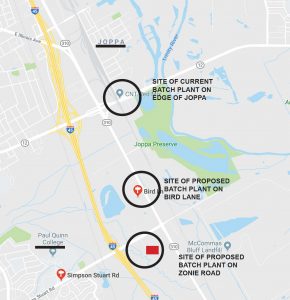Posts by jim
Build a Better Bus Stop Design Contest Another Step Toward Improving Public Health for Transit Riders
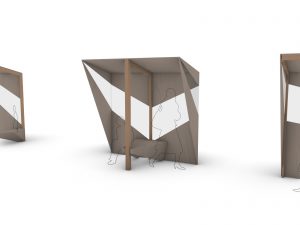 Inspired in part by its recent collaboration with Downwinders, Dallas-Based Better Block Foundation’s annual FD19 design competition is focusing on how to build a better, and more protective bus stop for transit riders
Inspired in part by its recent collaboration with Downwinders, Dallas-Based Better Block Foundation’s annual FD19 design competition is focusing on how to build a better, and more protective bus stop for transit riders
First orientation is January 16th, with milestones all the way up to the debut of the winning design in May. Better Block was founded a decade ago by Oak Cliff resident Jason Roberts. It “educates, equips, and empowers communities and their leaders to reshape and reactivate built environments to promote the growth of healthy and vibrant neighborhoods.”
Better Block recently helped out Downwinders during our Electric Glide Bus Pub Crawl by providing the spiffy portable stage used by Proterra founder Dale Hill at our stop at the Convention Center recharging station.
Originally both groups had more ambitious plans to design and build a number of pop-up bus shelters to test ideas on how better to protect waiting riders from street level Particulate Matter pollution and donate them to DART. DART had other ideas…and a long list of very particular specs to make the shelters official.
Despite this institutional resistance Better Block is determined to do some good and offer constructive suggestions. They requested and got DART’s long list of specs and are incorporating them into this year’s contest to DART won’t have any reason to reject them out of hand.
Despite these obstacles Better Block is determined to do some good and offer constructive suggestions. They requested and got DART’s long list of specs and are incorporating them into this year’s contest to DART won’t have any reason to reject them out of hand.
Why bus shelters? Studies show transit riders are among those most heavily exposed to PM pollution. One reason is they’re standing or sitting beside busy roadways, sometimes in shelters that actually trap PM pollution. Better Block wants to help design shelters that do actually reduce a waiting riders exposure to PM. 
Better Block Director Krista Nightengale explained “There are a couple things that led us to this: 1. Downwinders at Risk brought to our attention a recent study that showed that you could cut PM exposure by 30-40 percent by simply rethinking the bus stop So we want to think about how to reposition the bus stop to better protect people as they wait. 2. This is something we’ve seen/felt as we wait for the bus: many times, the stop is literally a pole in the ground. So how can we use what we do to give folks a place to sit and give them shade? And how can we make bus stops fun? “
Her comment and commitment are gratifying. It’s similar to what a DART board member told us after a discussion: “We never thought about PM before Downwinders brought it up.”
DART has never considered PM pollution in any of its decisions regarding bus type or bus shelter design.
Better Block’s decision to make better bus stops the center of their annual design competition is another small success story in Downwinders’ efforts to raise awareness about the dangers of PM pollution. We can’t wait to see the prototypes.
Plan Commission Zoning Vote for Bird Lane Batch Plant: Round 2
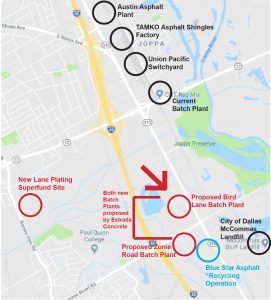
Dallas Plan Commission Hearing Scheduled
for Thursday January 17th, 1:30 pm
Dallas City Hall Rm 5ES
Speak Out Against
Systematic Environmental Racism
1) CLICK HERE TO SEND AN EMAIL TO
THE PLAN COMMISSION RIGHT NOW
Urge them to deny these permits…and consider a moratorium on ALL new industrial permits south
of the Trinity River “until the City can provide
a way to insure the same neighborhoods
are not always chosen to host them.”
2) SHOW-UP AT THE HEARING ON THE 17th
and speak against the zoning change
that Estrada Concrete is seeking.
Thanks in part to your emails, the Plan Commission delayed routine approval of the Bird Lane batch plant at its December 13th meeting and scheduled an individual hearing for Thursday, January 17th that could start as early as 1:30 pm at Dallas City Hall.
If you didn’t get a chance to send an email opposing the batch plant to the Plan Commission in December and want to do so you have that chance through our revised Featured Citizen Action “clickNsend” messaging. If you did send one in, send another.
This time, you can not only tell the Commission you oppose this specific permit…but ALL new industrial permits south of the Trinity River until the City of Dallas quits dumping all new polluters there.
We know the Bird Lane Batch Plant will be on the January Commission agenda but residents may be facing a twofer by then. The same company pursuing the Bird Lane site is also looking to put another new Batch Plant on Zonie Road right around the corner. After initially rejecting that effort because the paperwork wasn’t correct, it seems to be back on track up for Commission action as well – we just don’t know when yet.
All of this is just down the street from Blue Star Asphalt “Recycling” mess, aka Asphalt Mountain, current industry in Joppa, and close to the new Lane Plating Superfund site.
It seems certain that at the very least, the Plan Commission will decide on a Special Use Permit, or SUP, that Estrada Concrete needs to operate a concrete batch plant on the Bird Lane property for a minimum of three years..
Opposition is based both on the specific problems the batch plants would cause for neighbors, and the fact that this part of South Dallas already has a disproportional amount of polluting industries.
THANKS!
You generated over 60 letters of opposition to the Bird Lane Batch Plant
Zoning Vote for Bird Lane Batch Plant Pulled from December 13th Plan Commission Agenda
Individual Hearing Scheduled
Thursday January 17th, 1:30 pm
Dallas City Hall Rm 5ES
Speak Out Against Environmental Racism
The first of two Estrada Concrete batch plants proposed for right around the corner from Blue Star Asphalt Recycling and initially slated to be routinely approved as part of a group of more mundane zoning requests, is now scheduled for its own hearing and vote next month.
Thanks to neighborhood opposition, including, God Bless Them, Temeckia Dorrough and Marsha Jackson plus the Inclusive Communities Project, institutional opposition from near-by Paul Quinn College, and over 60 letters generated through the Downwinders’ Click N Send feature, the Plan Commission pulled the batch plant form its consent agenda on December 13th and scheduled a separate hearing and vote on the case for January 17th.
Had vigilant citizens not plugged-up the City Hall pipeline, this is a zoning change that would have passed easily with full staff support and without even a record vote by the Commission.
At stake is issuance of a Special Use Permit, or SUP, the owners need to operate a concrete batch plant on the Bird Lane property for a minimum of three years.
Still unknown is when the OTHER Estrada Concrete batch plant also gets the green light for a scheduled vote. It’s proposed for Zonie Road, immediately adjacent to and downwind of homes and a shingle’s throw from troubled Blue Star Asphalt Recycling. It’s possible both sites could be on the same January 17th Plan Commission agenda.
The Bird Lane site is already zoned Industrial Research (IR) while the Zone Road site is zoned Agricultural with a pending request to zone it Industrial Research as well. IR and Industrial Manufacturing, or IM zoning next to minority residential neighborhoods along the Trinity River has been the source of most local environmental justice battles.
Opposition is based both on the specific problems the batch plants would cause for neighbors, and the fact that this part of South Dallas already has a disproportional amount of polluting industries.
Come January we’ll be adjusting our Click N Send messaging to reflect the new Plan Commission hearing and vote date and let you know when you can have another big impact with your letters of opposition.
Discussion of both these proposed batch plants and the underlying zoning issue which keeps facilities like this coming to South Dallas will be on the agenda at the next “Let Joppa Breathe” Alliance meeting, scheduled for January 14th.
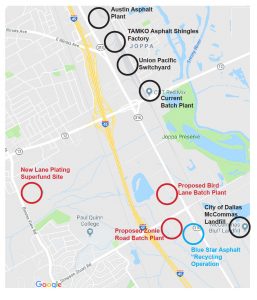
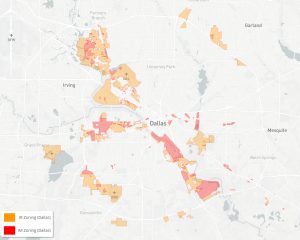
Xmas Brings a “Miracle on Choate Street”

Blue Star “Recycling” exposed by citizens and
reporter as one big illegal asphalt dumping
ground in South Dallas
City forces closure…once it finds out about it
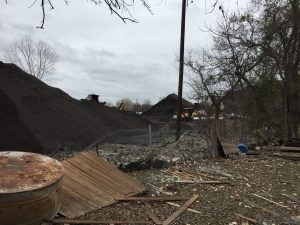
The view from Marsha Jackson’s backyard
Last week there was what you might describe as a kind of South Dallas Christmas Miracle Story – as in, “It was a miracle the city finally did anything to stop that crap.”
For a blow-by-blow account of how it all went down, you can read Dallas Morning News city columnist Robert Wilonsky’s account in two separate installments that ran in last Thursday’s and Friday’s paper here and here.
They tell the saga of Marsha Jackson’s one-woman fight to save her home of almost 30 years from being swallowed up by huge mountains of asphalt and used shingles by a company claiming to recycle them. A company that only popped up in the last 12 months or so and has completely destroyed her quality of life.
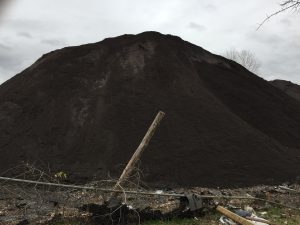 No photos or video can do her situation justice. Towering 3-5 story piles of what looks like coal dust are looming over her house, right up to the fence line that’s broken because of them. Heavy-duty diesel equipment is everywhere and in constant motion, moving piles of asphalt chips and shingles around. Large shingle-shredding machines spit out chips from both ends. A foul-smelling asphalt cooking operation adds a sulfuric haze. It goes on well into the night.
No photos or video can do her situation justice. Towering 3-5 story piles of what looks like coal dust are looming over her house, right up to the fence line that’s broken because of them. Heavy-duty diesel equipment is everywhere and in constant motion, moving piles of asphalt chips and shingles around. Large shingle-shredding machines spit out chips from both ends. A foul-smelling asphalt cooking operation adds a sulfuric haze. It goes on well into the night.
Ms. Jackson has been complaining about this situation to everyone, from the Texas Commission on Environmental Quality to the City of Dallas, for over a year. Despite her best efforts those complaints never got heard or acted upon. It might have remained that way for a good while longer.
Instead, what happened to Ms. Jackson is the kind of thing that usually only happens in movies.
On November 13th, Ms. Jackson met tenacious Temeckia Durrough of the Joppa Freedman’s Township Association at a community meeting about the new Lane Plating Superfund site in South Dallas. They exchanged their own outrages. Temeckia invited Ms. Jackson to come to the next Let Joppa Breathe Alliance meeting on December 4th to tell her story and add some people power.
She did and then she begin sending photos and video of what was right outside her window. Those prompted visits to collect our own evidence. Sprawling over multiple acres, artificial ridges of asphalt bits and and shingles ring the site and come right up to the edge of a creek that flows into the Trinity River a short distance away. There’s nothing to keep those piles from sliding into the creek and sure enough, that’s what’s been happening over the last year.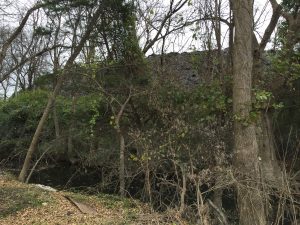
Exasperated by the actual site, Downwinders then reached out to a handful of local reporters capable of throwing a hot and heavy spotlight on an injustice. “Please help this woman living under/on top of a growing giant asphalt blob“ was the subject line of our December 10th plea. We suspected the only way to cut through all the reasons why nobody could help Ms. Jackson was to expose the fact that nobody was helping her.
To his credit Dallas native Robert Wilonsky, city columnist for the Dallas Morning News, answered the call. He went out to Marsha Jackson’s house and like everyone else except the agencies who are supposed to be outraged by this kind of thing, was indeed outraged. And that’s when things started to happen.
After trying to get basic information on Blue Star from Dallas City Hall he was even madder. Like the rest of us mere citizens, he was told he’d have to file an Open Acts Request – just to see the city inspection files, certificate of occupancy, etc. But maybe the reason the City didn’t want anyone looking is because Blue Star didn’t have ANY of the necessary paperwork to do what it’s doing, as Wilonsly later found out.
Because he was snooping around City Hall, Wilonsky was contacted by District 8 City Council Member Tennell Atkins on Wednesday, December 12th. Wilonsky urged Atkins to look into the awful situation…in his own council district. That he’d been getting complaints about for months.
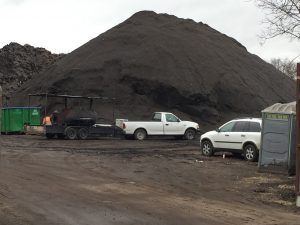 But after a visit, code compliance officer in tow, Atkins was full of righteous indignation. As was the Dallas Office of Environmental Quality and (Rockefeller) Sustainability, whose Director only learned about Blue Star from Wilonsky in passing…on Thursday the 13th, when Wilonsly’s first column on Blue Star went up in the early afternoon.
But after a visit, code compliance officer in tow, Atkins was full of righteous indignation. As was the Dallas Office of Environmental Quality and (Rockefeller) Sustainability, whose Director only learned about Blue Star from Wilonsky in passing…on Thursday the 13th, when Wilonsly’s first column on Blue Star went up in the early afternoon.
By Friday, December 14th, a month and a day after Marsha Jackson and Temeckia Durrough first met, the City was filing motions in court to close Blue Star down for at least a week. Considering how much official paperwork is lacking on the site, the fact that it’s the subject of an on-going TCEQ investigation, and is sorely liable to lawsuits by its neighbors, let’s hope it never opens again.
We don’t know how those huge piles are going to get cleaned-up yet but at least they’re not being added to. For now, the activity on the site that was a constant nuisance and health threat to Marsha Jackson has ceased.
In less than seven days the phone calls and emails of the most widely read local columnist for the only daily in town won a victory that months of campaigning through official channels by an ordinary citizen had been unable to pull off. Time and again the system let Marsha Jackson down until that institutional failure was the story that made the outrage stop.
Call it Ms. Jackson’s own hard-won Christmas Miracle.
Was it not for her persistence, this series of unlikely events could not have happened. Were it not each supporting link in the chain along the way – Ms. Douglas’ fateful invitation to Jackson to attend a community meeting, our gigging local journalists, one of those journalists actually being interested – there would be no happy ending to report yet. That’s how tenuous environmental justice is in Dallas.
Besides showing the rewards of desperate determination, it was a lesson in grassroots perspectives for Reporter Wilonsky as well. Like most of us, he was dumbstruck by the fact that you can’t simply make an appointment to show up at City Hall, sit down, and read the official records on a company doing business next to you. Like many of you, he found out firsthand how passive the City is toward on-going disasters like the one next door to Ms. Jackson…until they become fodder for a front page column.
But we can’t depend on a single reporter to do the work of whole agencies, no matter how influential. This was the exception that proves the rule.
Even while the spotlight shone brightly on Blue Star, a hearing on a zoning change allowing a new concrete batch plant right around the corner was taking place at City Hall with a recommendation by city staff that it be approved. It’s one of two being sought in the same stretch of SM Wright freeway, which isn’t too far from the new Lane Plating Superfund Site, which isn’t too far from the TAMKO asphalt roofing shingles factory, the large Union Pacific switch yard, the Austin Asphalt plant and the Redi-Mix batch plant in Joppa. Fortunately, citizens were there to stop that mistake from happening as well.
Instead of seeing these as individual facilities like City Hall does, they should be seen as symptoms of the same problem of obsolete racist zoning plaguing South Dallas. As long as heavy industry is allowed to plop down next to homes in a way not allowed in east or north Dallas, you’ll see wave after wave of Blue Stars and batch plants targeting this area.

A wholesale examination of industrial zoning, of zoning that pollutes, should be taking place at Dallas City Hall as part of its revamped Economic Development policy. In the same way that the City recently said it won’t be a party to adding to concentrations of poverty through the siting of low income housing, it should also be policy not to add to concentrations of pollution in neighborhoods already absorbing more than their fair share. This requires a proactive perspective that has no sign of showing up within the ranks of the Office of Environmental Quality and (Rockefeller) Sustainability staff any time soon. That means residents are going to have to do this themselves – despite staff.
Just like Ms. Jackson, they’re going to have to be persistent in their demands. They’re going to have to stay focused. And maybe, just maybe if the right combination of chords can be struck, in the right sequence, at the right time, another more far-reaching chorus of “Hallelujah” can be sung in praise of a civic miracle. This time for all of South Dallas.
Environmental Justice Alert! Help Us Stop the First of Two New Batch Plants Proposed for South Dallas
Plan Commission Action THIS Thursday
You can send a email opposing both proposed batch plants to the Plan Commission today
JUST CLICK HERE
On Thursday the Plan Commission will vote on an SUP for the Bird Lane batch plant site – one of two being proposed by Estrada Concrete along the Stuart-Simpson/Central corridor in South Dallas.
There is more than a little suspicion that this is a backdoor way to get the pair of batch plants that were defeated by Joppa residents in March back in play – only in a more business-friendly council district. The two new requests are coming from a very small company run out of a house with only one batch plant in operation now, located in an industrial park in Hutchins just six minutes down the highway.
To defeat this bad idea we need you to:
1) let the Plan Commission know you oppose the batch plants and the zoning changes they require ASAP. Please use our simple ClickNSend email letter template to send a letter of opposition. Add your own comments if you want. It’s already addressed to all the Plan Commission members. All you have to do is fill it out and “click send.”
2) show up on Thursday at the Plan Commission to voice your opposition in person if you can:
DALLAS CITY HALL
CITY PLAN COMMISSION MEETING
THURSDAY, DEC 13th
ROOM 5ES
1:30 pm
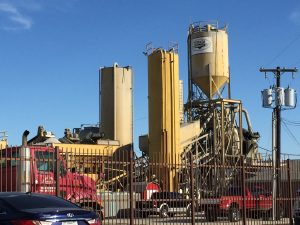
Staff has recommended approval of a Special Use Permit to operate a batch plant for three years at this Bird Lane site, which is next to homes and right around the corner from a second batch plant site the same company – Estrada Concrete – is pursuing via a zoning change request.
Since there are two sites there are two votes. The other site won’t come up for a vote until January 3rd at the earliest, but this Bird Lane site is gong through the pipeline now.
What’s needed now is sending these Plan Commission members lots and lots of emails saying we oppose these zoning changes and Special Use Permits AND are seeking a individual hearing for the Bird Lane site on the 13th.
There are two different types of agenda items when it comes to city decisions. One is the “individual” agenda item for which topics will be discussed and the public can make comments.
The other type of agenda item is a “consent” agenda item in which case the topic is not discussed and the group simply votes on it with the understanding that most agree with what is being proposed.
In this case, the batch plant’s Specific Use Permit (SUP) request has been recommended by staff for approval for a three year period and it is assumed that none of the city plan commissioners oppose the staff recommendation.
Dallas residents opposing this Bird Lane batch plant should contact their own District’s Plan Commissioner and City 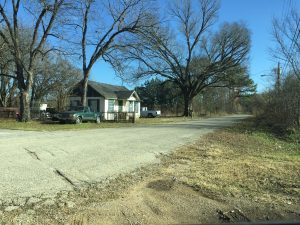 Council Member and let them know know you want the Plan Commission to pull the item from the “consent” agenda so it will individually discussed on the 13th as part of the public hearing portion of the agenda instead of the done deal “consent” part.
Council Member and let them know know you want the Plan Commission to pull the item from the “consent” agenda so it will individually discussed on the 13th as part of the public hearing portion of the agenda instead of the done deal “consent” part.
A hearing requires the public to be heard and a recorded vote take place by Plan Commission members for some kind of action – Delay, Disapproval, or Approval. We get to make our case against the batch plant only if it’s pulled off the consent agenda.
Folks opposing the zoning change may speak against the staff’s recommendation if they choose. The hearings start at 1:30 PM and can last through the early evening. It’s hard to tell what time the item will be heard, so be prepared to come and stay awhile.
The CPC docket is available https://dallascityhall.com/government/meetings/DCH%20Documents/plan-commission/12-13-2018_CPC_Docket.pdf
CLICK HERE TO SEND YOUR LETTER OF OPPOSITION
Thanks to everyone who made the 1-Day University of Change a Useful and Productive Day







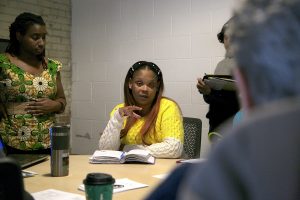
Full-up: Our 2019 College of Constructive Hell-Raising Class is the Largest Ever
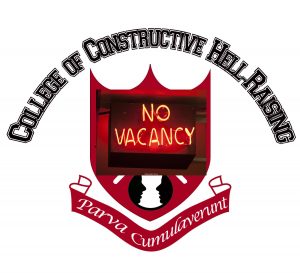
Downwinders is happy to announce our 2019 College of Constructive Hell-Raising Class
is completely full and the largest ever at 20 students. Circumstances may change however, so we’re creating a stand-by list just in case there are any drops. Let us know if you’re interested thru our downwindersatrisk@gmail.com address.
Besides being the most sizable, the class of ’19 looks to be one of our most diverse in terms of background, experience, and interests. We’re excited to share the semester with them.
Class of 2019
Samia Anas
Deyadira Arellano
Divya Babbula
Andrea Bazemore
Patricia Brown
Soraya Colli
Howie Darter
Temeckia Douglass
Rosetta Howard-Jackson
Samira Maddox
Susie Marshall
Deborah Murphy
Gerardo Rendon
Patrick Robinson
Sherlyn Samuel
Stephanie Timko
Michael Tomaso
David Villalobos
Amber Wang
Whitney Wolf
San Antonio and Houston Move Forward with New Regional Air Monitoring Networks. Dallas Doesn’t.
Last time we reported on the prospects of a new regional air monitoring network the idea received a 7-0 vote from a Dallas City Council Committee on September 24th but was delayed by staff request from going to the council until December 12th.
There was conjecture at the time that the delay was an excuse to actually find ways to kill the idea and if that was the goal, it’s 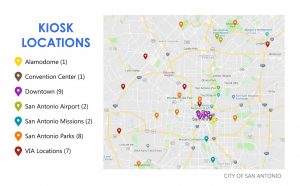 succeeding so far. After a year of hearing no objections from Dallas staff to the idea of establishing an independent entity among local governments to run the network, all of a sudden City Hall took great offense at the very idea.
succeeding so far. After a year of hearing no objections from Dallas staff to the idea of establishing an independent entity among local governments to run the network, all of a sudden City Hall took great offense at the very idea.
Over the past month Dallas County has been in talks with Dallas city staff to find another way to implement the network. Government-sponsored non-profits are being studied. Downwinders continues to advocate a entity that assures public participation in decision-making and robust enough to maintain a growing network of different monitors in different cities. Without more progress being made quickly it’s hard to figure out how the proposal makes it before the Council by December 12th.
While Dallas delays, both San Antonio and Houston are proceeding with their own new air monitoring networks.
In San Antonio, it’s through a deal with IKE Smart City that will trade ads on kiosks for 30 free kiosks that will give directions, recommend local eateries, provide free WiFi in a 150-foot radius, and take Particulate Matter pollution readings. The project is funded entirely by IKE Smart City. Unlike DFW, San Antonio hasn’t even violated the Clean Air Act and it already has more monitors than the Metromess.
 Beginning in December 2017 the Environmental Defense Fund working with the Houston Health Department and the university of California Berkley placed 20 air quality sensors across the city. Some were placed in known pollution hots spots like the predominantly black neighborhood of Pleasantville on Houston’s east side, where pollution from warehouses, metal recyclers, salvage yards, an Anheuser-Busch’s Houston brewery and an interstate often make it hard to breathe.
Beginning in December 2017 the Environmental Defense Fund working with the Houston Health Department and the university of California Berkley placed 20 air quality sensors across the city. Some were placed in known pollution hots spots like the predominantly black neighborhood of Pleasantville on Houston’s east side, where pollution from warehouses, metal recyclers, salvage yards, an Anheuser-Busch’s Houston brewery and an interstate often make it hard to breathe.
“If somebody asked me how many fixed site monitors we need, I would say there are never enough,” said Loren Raun, chief environmental officer with the Houston Health Department, which has since received funding to purchase similar instruments from Entanglement Technologies.
One can’t imagine anyone on Dallas city staff saying the same thing. In fact on more than one occasion staff has said they’re just fine with the nine monitors the Texas Nature Conservancy is due to be installing at Dallas schools this year and they’re in no rush to add any more.

Just another day in Joppa
And one especially can’t imagine Dallas city staff going along with putting monitors in known Dallas pollution hot spots like Joppa or West Dallas. Despite the recent controversy over the proposed two new batch plants rejected by the City Council in March – in part because of portable monitor readings from Downwinders showing already high levels – staff said recently they still have no plans to purchase their own air sensors.
This kind of official rebuff to high tech low cost sensors gives lie to the city staff’s rhetoric about “Smart Cities”as well as its sudden concern over asthmatic black kids. If staff really cared about them, why wouldn’t it buy air monitors it could use in field to investigate complaints in their neighborhoods instead of just guessing the air quality there, or using an EPA monitor nine miles away to claim everything was just fine? Why wouldn’t the City be rushing to install monitors in hots spots like Joppa? Because statements made in pursuit of Rockefeller Foundation grants do not carry the force of law, or even as it turns out, curiosity.
Electric Buses: A Big Climate Change and EJ “Something You Can Do Now”
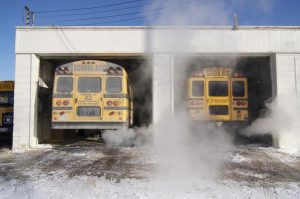
Register for the Electric Glide Bus Pub Crawl here.
Thursday, December 6th
Catch the bus at 6:30 or 7:00 pm
at the Green Door in the Farmers Market District
600 South Harwood Dallas 75201
Plug In. Get Lit. Stay Current.
How did we get from cement plants burning hazardous waste in Midlothian to transit or and school buses making runs in inner city Dallas?
The answer is PM, Particulate Matter. The two-decade fight against the cement plants was one long primer on PM pollution. They were, and remain the largest industrial sources of the pollution in North Texas. We learned firsthand about the toxicity, reach, and insidious health effects of PM pollution. Not just strokes and asthma, but IQ loss, Autism, Dementia, Diabetes, low-weight births. PM is the new lead.
Every boiler, furnace, fire, flame and combustion engine produce PM. Diesel engines emit an exceptionally toxic form of PM called Black Carbon.

Because they’re on the road so much, are diesel or natural gas-powered, and make people wait by the side of traffic-heavy roads to ride, bus systems turn out to be a major source of PM pollution. And climate change gases. And smog. A rough estimate shows DART’s bus fleet would be the 10th largest PM source in Dallas County if it were all parked in one spot. But of course its the dispersed nature of a bus fleet’s pollution that often makes it more of a widespread threat to public health than a stationary “point source” a.k.a. an industrial facility.
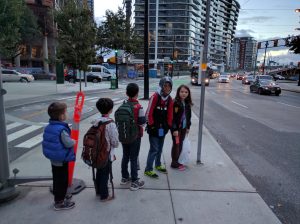
What’s missing is a constituency for electrification of school district bus fleets and transit agencies like DART and Trinity Metro. Because of the potential impacts and benefits, this could be a wide-ranging and powerful alliance – PTAs, transit riders, physicians, environmentalists, environmental justice advocates, and even the utilities that could buy the power from bus batteries. But until we get the ball, er wheel rolling, its all just that – potential.
One of the reasons we’re sponsoring the December 6th “Electric Glide bus pub crawl” as part of this year’s Root and Branch is that we wanted to start that rolling. And real, wheels-on-the-bus-go-round-and-round rolling discussions and presentations on the advantages of electric buses are part of the evening, but so is just showing your support for the goal of electrification as something local officials could accomplish right now, especially if they combine their collective purchasing power.
The more people that show-up on the 6th, the more DART and local school boards – whose memberships we’re inviting as well – will get the impression someone gives a damn and the more we’re a force to be reckoned with. We need a people’s lobby for 21st Century electric buses in DFW.
 In exchange for coming out and forking over $25, we give you three custom drinks, Graham Dodds’ food, a presentation by Dale Hill, the co-founder of the Proterra electric bus manufacturer, and maybe, just maybe some food for thought about what we all can do right now to advance a bunch of causes in one campaign that’s winnable at the local level in the Trump era.
In exchange for coming out and forking over $25, we give you three custom drinks, Graham Dodds’ food, a presentation by Dale Hill, the co-founder of the Proterra electric bus manufacturer, and maybe, just maybe some food for thought about what we all can do right now to advance a bunch of causes in one campaign that’s winnable at the local level in the Trump era.
Register for the Electric Glide Bus Pub Crawl here.
Thursday, December 6th
Catch the bus at 6:30 or 7:00 pm
at the Green Door in the Farmers Market District
600 South Harwood Dallas 75201
Plug In. Get Lit. Stay Current.
Council Member (& Dallas Mayoral Candidate?) Scott Griggs is 1-Day University of Change Lunch Speaker
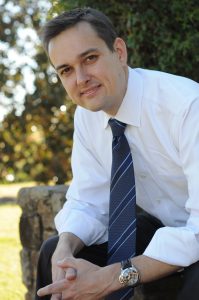 If a full day of informative workshops by experts, networking with other local activists and organizers, plus lunch wasn’t enough to get you interested in coming to our 1-Day University of Change on Saturday December 8th, what about a mid-day briefing from long-tine Oak Cliff Council Member Scott Griggs on the importance of the upcoming May municipal elections – an election that may see him running for Mayor of Dallas?
If a full day of informative workshops by experts, networking with other local activists and organizers, plus lunch wasn’t enough to get you interested in coming to our 1-Day University of Change on Saturday December 8th, what about a mid-day briefing from long-tine Oak Cliff Council Member Scott Griggs on the importance of the upcoming May municipal elections – an election that may see him running for Mayor of Dallas?
Griggs is associated with “good government” initiatives making City Hall more transparent and accountable, but he’s also been a forceful advocate for New Urbanism “green government.”
Although widely remembered as a critic of the now-dead Trinity Toll Road, Griggs was first elected in 2011 with quite a bit of help from Dallas gas drilling opponents.
Seven years ago the Barnett Shale was still hopping and every local government was trying to cash in without concerns of any downside. Fights over drilling restrictions in Fort Worth, Southlake, and Grapevine had preceded the Dallas battle and industry wanted to impose the “Fort Worth model” of unchallenging drilling provisions on Dallas.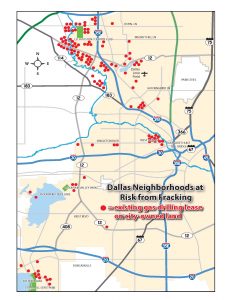
In 2011, nobody had yet discovered the secret agreement between then City Manager Mary Suhm and Driller Trinity East that gave permission to do all kinds of things not allowed by the city at the time – like drilling in floodplains and parks. City staff was going out of its way to shepherd drilling permits for the company through the bureaucracy even as citizen opposition convinced other drillers like Exxon to pull out of Dallas. Nobody could figure out why until the secret agreement was leaked to the Dallas Observer. There’s no direct evidence of who released the agreement, but speculation centered on Griggs, and then-city council member Angela Hunt.
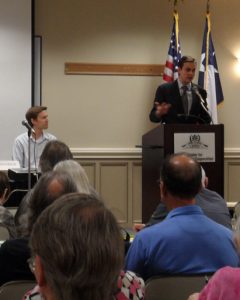
CM Scott Griggs addressing citizen Town Hall on gas drilling in 2012
From that point forward citizens begin winning more votes at the Planning Commission and Council. First to go was the favoritism staff had shown the proposed Trinity East drilling permits. They were defeated outright and resulted in a lawsuit filed by the company still in the courts over who promised to do what for whom. In the wake of their demise, the most protective gas drilling ordinance then proposed for any Texas city was passed by the Dallas Council. It established a more restrictive “Dallas model” to counterbalance the more lenient Fort Worth one.
If the only major accomplishments of Griggs city council years was killing the Zombie Toll Road and saving Dallas from irresponsible gas drilling, he’d have earned his pay. But those are only two of the many battles Griggs has fought with City Staff and his more establishment-oriented colleagues. The recent historic change in the city’s housing policy was fueled by his reforms. For the first time the City has made it policy not to keep concentrating subsidized housing in South Dallas areas which already have more than their fair share amidst high rates of poverty and lack of employment opportunities.
He’s one of a handful of council members who’s made it their business to take on entrenched city staff  time and again over issues of responsiveness and common sense. Even though he sits on the other side of the horseshoe, he has the healthy skepticism of a citizen still fighting City Hall.
time and again over issues of responsiveness and common sense. Even though he sits on the other side of the horseshoe, he has the healthy skepticism of a citizen still fighting City Hall.
We’re not the only ones who hold a high opinion of Griggs. D magazine names him “Best Politician” in 2012 and Best Public Official 2016. the Dallas Observer named him Best Politician (2012) and Best Council Member (2013, 2015). The venerable Oak Cliff Conservation League gave him their Oak Cliff Warrior Award in 2015.
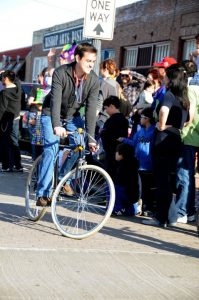 Griggs terms-out as of this coming May and speculation is running high that he’s preparing to run for Mayor. If he wins there’s no doubt he would be the most progressive mayor for Big D since Laura Miller ten years ago. Depending on who takes his place and what other candidates win, Dallas could end up with an 8-vote solid voting progressive/green majority for Griggs. That promise of a truly reform-minded council is what’s motivating a new wave of anticipation for the municipal elections, especially after a very successful November in Dallas County as a whole.
Griggs terms-out as of this coming May and speculation is running high that he’s preparing to run for Mayor. If he wins there’s no doubt he would be the most progressive mayor for Big D since Laura Miller ten years ago. Depending on who takes his place and what other candidates win, Dallas could end up with an 8-vote solid voting progressive/green majority for Griggs. That promise of a truly reform-minded council is what’s motivating a new wave of anticipation for the municipal elections, especially after a very successful November in Dallas County as a whole.
Downwinders is proud to host the lunch time briefing from Council Member Griggs. Just as progressives used the recent mid-terms as a way to build a bluer Congress and State House, locals will be seeking to use the May Dallas elections to seat the most environmentally friendly city council it’s ever known.
Local governments are becoming the launching pads for change as state and federal agencies retreat or surrender their basic quality of life responsibilities. Having a progressive majority in Dallas that could join this effort would be a huge jump start for all kinds of good things to happen.
If Griggs decides to run (the window for filing to run in May begins January 16th) 1-Day University participants could get a sneak peak at the kind of vision he’ll be promoting for the city, maybe a trail run at a stump speech. For Dallas environmentalists, the May elections may actually begin at lunch on December 8th. Make sure you’re there.
Sign up for the 1-Day University here, or pay at the door.
